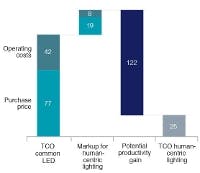LightingEurope publishes research on LED-based human centric lighting
Human-centric lighting, generally tunable solid-state lighting (SSL) that increases our comfort or wellbeing, can become a significant segment of the overall LED-based lighting market, according to LightingEurope. A joint study by LightingEurope, the German Electrical and Electronic Manufacturers’ Association (ZVEI), and consulting firm A.T. Kearney projects human-centric lighting as a multibillion-Euro business that could hit EUR 1.4B (billion) in 2020.
Human-centric lighting can have a range of positive impacts on society, according to the new research and other studies on the topic. At its simplest, such lighting allows us to sleep and rest best and perform with greater productivity during waking hours. Tunable lighting has also been shown to accelerate healing and help prevent chronic diseases. The study states that European industry is uniquely poised to capitalize on the opportunity in part because of a "solution-oriented understanding of customer requirements."
Human-centric lighting goes beyond the basic visual needs of people. Our populace is spending greater periods of time indoors and quality lighting is imperative for health. Technologies such as tunable color and white point take the concept further to enhance the daily lives of people. "Human-centric lighting solutions can actively support the circadian rhythm of human beings, thus promoting a person’s wellbeing, mood, and health.” says Alfred Wacker, chair of LightingEurope’s Light and Health Working Group. If you need some background on the topic, view our webcast on the subject from last November.
LEDs will become dominant source
The new study notes that most human-centric lighting to date has been based on fluorescent sources, mainly because of the cost of LEDs. By 2020, however, LEDs will take over 90% of the human-centric lighting space, according to the researchers.
Indeed, LEDs enable many of the key elements of human-centric lighting. The new study says that lighting can meet our visual, biological, and emotional needs via control of direction of light, color temperature, and illuminance levels. LEDs are unique among light sources in enabling control in each of those dimensions.
The study justifies the optimistic viewpoint for human-centric lighting using case studies that detail a full financial analysis of applying the technology. In a factory application that is detailed in a nearby figure, a 25% upfront price premium and 20% greater power consumption of tunable lighting is offset by productivity gains.
The study is available on the Lighting Europe website and includes projections for chronology of adoption and the applications where human-centric lighting will be prominent. Examples of the latter include shopping, hospitality, health, education, office, industrial, and residential. The health sector will drive adoption initially but education is projected as the driver by 2020.
Assuming the technology takes off as projected, it will make up 7% of the overall European lighting market by 2020. The strongest penetration could come in northern areas such as Sweden where days are short during the winter.






